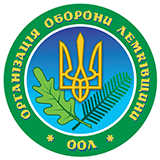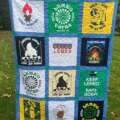
In the XVII century the situation was a difficult for peasants in Western Ukrainian lands. Compulsory service for a landlord lasted 5-6 days per week, and moreover, peasants were obliged to carry out different duties and construction and repair work. Noble estates and royal lands in Lemkivshchyna demanded that the inhabitants pay for the grazing of cattle except during the period that they were fulfilling their compulsory service.
German colonists received an allotment of land and forest in Lemkivshchyna for a trifle and they built their enterprises and houses here and brutally oppressed the local population.
Some separate villages were often sold to owners. Thus, in 1536 the village of Doshno [Deszno] was sold to Konstyantyn Hlodyns’kyy for 200 gold coins. He had the right to stock a pond and to catch fish. The new owner of the village was granted the right to receive one third of the money from court cases and a sixth of the proceeds from taxes. Peasants had to give their landlord four kirks of rye and oats from each field as well as paying taxes and cultivating the landlord’s field for nothing. The landlord had the right to punish people for their disobedience.
This economic oppression was coupled with religious and national oppression. Landowners, Polish nobility and priests tried to Polonize the Ukrainian people. In the charter granting ownership of Dyniv [Dynów] to K. Vapovs’ka in 1592, there was a requirement that all Orthodox Churches be converted to Roman Catholic Churches. It was further stated that “the priests proposed by us (Polish nobility – I.K.) must beforehand return the Rus’ (Ukrainians) to the holy Roman Church.”
The majority of the Ukrainian villages in Lemkivshchyna were transferred to the possession of Krakow bishops who forced Ukrainians to go to Roman Catholic churches. Bishop M. Shyshkovs’kyy in his charter of 1626 prohibited the building of Eastern Rite churches in the territory of Mushyna [Muszyna], and Mushyna was Latinized by force. By the order of Bishop Zadzik in 1636, an Eastern-Rite church in Tylicz was shut down; later it was pulled down. The materials were delivered to Mushyna to construct a Roman Catholic Church.
Mass protests started and gradually turned into the great war against the Polish nobility for the liberation of the Ukrainian people under the leadership of Bohdan Khmelnyts’kyy. Not only Ukrainian peasants, but also Polish peasants in Subcarpathia responded positively to the war and were sympathetic to it. There was a common interest between the Ukrainian and Polish peasantry which united them in the struggle against the Polish nobility.
A mass of peasants ran to the hills, formed groups, hid in deep inaccessible caves and attacked the manors of the noblemen. Others refused to carry out their obligations to landowners.
They then organised groups of partisans who were called “Zbiynyky” in Lemkivshchyna. They were loved by the people, who praised their defenders in songs and legends. Lemkos still remember Tserhova Hill, “Zbiynyts’ka cave” near Perehrymka [Pielgrzymka], the caves above the Dunayets’ [Dunajec] River and other places where the Lemko rebels stayed.
The core of the partisans was made up of the popular masses, as they gathered unto themselves the poor villagers, hirelings, and shepherds, whose situation was the most distressful. At the head of these partisans was an otaman – a very strong-willed and brave person. A band of Zbiynyky consisted of hundreds of strong young men. The activities of these folk Zbiynyky in Lemkivshchyna frightened the landowners whose lives and properties were constantly endangered.
Frightened by the rise of the peasant movement in Lemkivshchyna, the Polish nobility commenced a fight against the rebels and cruelly dealt with them. Thus, in May, 1614, a group of Zbiynyky was executed near Viche [Biczyce?]. The government of noble Poland ordered that all the roads and crossings in Subcarpathia leading in the direction of Hungary, where people formed groups and rose in rebellion very often, be closed and controlled.
But the people’s movement, which increased from day to day, spread to the urban population as well. In 1631 more than eight thousand peasants and burghers under the leadership of Stanislav Lentovs’kyy, the head of the municipality of Chornyy Dunayets’ [Czarny Dunajec], rose against the leader Komarovs’kyy in Novyy Torh [Nowy Targ].
Bohdan Khmelnyts’kyy, who knew about the people’s struggle in Subcarpathia, decided to strengthen his relations with the rebels in Poland. The hetman’s envoys, who reached to the very western borders of Poland, distributed letters in which Khmelnyts’kyy called peasants to the resolute struggle against the Polish nobility.
The Lemkos gladly welcomed the envoys of Khmelnyts’kyy, who were mostly disguised as musicians and merchants.
Khmelnyts’kyy’s plan included an utter rebellion of the peasants in Subcarpathia which successfully expanded. Large groups of peasants left their landlords and joined the rebels. The heroism of the Lemkos in this struggle was striking evidence of the unity of the whole Ukrainian people.
The Polish historian L. Kubalya wrote that “from the [San] and to Pidbeskyddya [the Lower Beskids], in the neighbourhood of Korosno [Krosno] and Duklya [Dukla], the Ukrainian people clung to the rebels, whose ranks were constantly reinforced by the highlanders.”
The rebellion intensified every day and enveloped not only Lemkivshchyna but also the lands beyond its borders.
Here and there the estates of the Polish nobility were burned. This was a reprisal against the oppressors by the detachments of Yurko Tsyupa, Lanko of Terstyana [Trzciana], Sypko of Velyka Matsyna [Mecina Wielka] (who perished near the village of Bortne [Bartne]), Leshko Romanyak from Mushynka [Muszynka], Hnatko of Vysochany [Wysoczany] and many others.
A group under the leadership of the brave otaman Vasyl Bayus made a successful attack on Yanushkovychi [Januszkowice] and killed the landlords Trojanowski, Bobownicki, Bylina from Lischyny [Leszczyny], and attacked Olszewski in Shary [Szczary] and Domaradzki in Ropa. Special groups were sent from Biche and Mushyna [Muszyna] to find Bayus.
The folk “Zbiynyky” supported the poor peasants, providing them with money and food. This is what the group of Petro Hudak from Snitnytsya [Śnietnica] did. The group consisted of Sydorchuk from Korolyk [Królik], Dzedzyk from Roztoka, Skirka from Han’chova [Hańczowa], Smolyak from Zhyvets’ [Żywiec], Mlynarchuk from Rehetiv [Regietów], Kvochka from Haladyshiv [Gładyszów], Bolonyar from Zhdynya [Zdynia] and others.
The detachment of Andriy Savka and Vasyl Chepets’ has become particularly famous for an attack in the spring of 1646, on Yamhund, the fortified manor of Mencinsky, and on the manors of Delnas in Hlynnyk [Glinik], Cikowski in Zheltsi and Kozlowski in Ropa. At that time, in the village of Velyslava (Vysova) [Wysowa] the Polish nobility sentenced to death the daughter of the peasant Marko, named Olenka. On the night before her execution, Savka’s group liberated her from prison.
The rebellion in Subcarpathia reached its height and organization in 1651, during the leadership of Kostko Napyers’kyy (Shymon Bzhovs’kyy). According to some historical documents, Napyers’kyy was in close cooperation with Khmelnyts’kyy and acted on behalf of him. According to some data he had visited Khmelnyts’kyy in 1650. There is evidence that Khmelnyts’kyy and Napyers’kyy concluded an agreement with the Hungarian prince Rákóczy concerning the mutual struggle against the Polish nobility.
This article first appeared in the weekly newspaper in Poland “Nasze Słowo” on April 14, 1957. It is reprinted here with the permission of the newspaper.



